2019 MERCEDES-BENZ CLA COUPE lights
[x] Cancel search: lightsPage 50 of 330
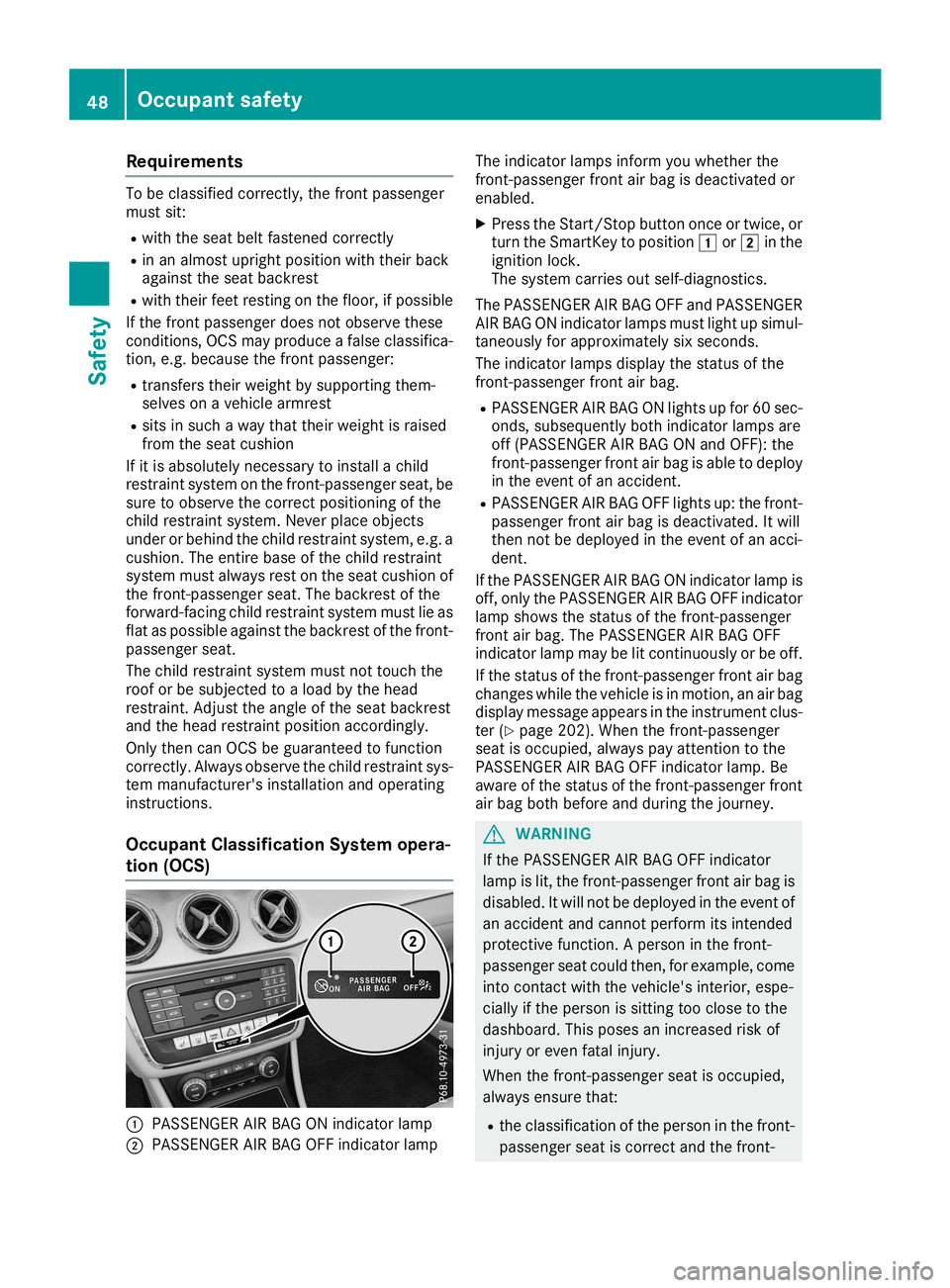
Requi
rements To
be classifiedcorre ctly,the front passe nger
mus tsit:
R with the seatbel tfas tened correctly
R in an almost uprig ht pos ition with thei rba ck
ag ainst the seatba ckrest
R with thei rfee tres ting onthe floor, ifpos sible
If the front passe nger doesnot observe these
condi tions,OC Smay produce afal se cla ssifica -
tion, e.g.because the front passe nger :
R trans ferstheirwe ight by supp orti ngthem-
sel ves onaveh iclearm rest
R sits insuch awa ythat theirwe ight israi sed
from theseatcus hion
If it is ab sol ute lyneces sary to insta lla chi ld
res trai ntsystem onthe front-p asseng ersea t,be
su re to obs erve thecorre ctpos itioning ofthe
chi ldres trai ntsystem. Neverpl ace obje cts
und eror beh indthe childres trai ntsystem, e.g.a
cus hion.The entir eba se ofthe childres trai nt
sy stem mustal wa ysres ton the seatcus hionof
the front-p asseng ersea t.The backrest ofthe
forw ard-faci ngchi ldres trai ntsystem mustlie as
fla tas pos sibleag ainst the backrest ofthe front-
pa sse nger seat.
The childres trai ntsystem mustnot touchthe
roo for be subjecte dto aload bythe head
res trai nt.Adju stthe angleof the seatba ckrest
and theheadres trai ntpos ition acco rdingly .
Only thencanOCSbe guara nteed tofuncti on
corre ctly.Alw aysobs erve thechildres trai ntsys-
tem manu facturer'sinsta llati on and operating
instru ctions .
Oc cupa ntClass ificati onSys tem opera-
tio n(O CS ) 0043
PASSENG ERAIR BAG ONindicator lamp
0044 PASSENG ERAIR BAG OFFindicator lamp The
indicator lamps informyouwh ethe rthe
front-p asseng erfront airba gis dea ctiva tedor
ena bled.
X Pre ssthe Start/Sto pbu tton once ortwi ce, or
turn theSmar tKeytopos ition 0047 or0048 inthe
ig niti onlock.
The system carriesou tsel f-di agnosti cs.
The PASSENG ERAIR BAG OFFandPASSENG ER
AIR BAG ONindicator lamps mustlight upsim ul-
tane ously for appro xima telysixseco nds.
The indicator lamps displ aythe statu sof the
front-p asseng erfront airba g.
R PASSENG ERAIR BAG ONlights upfor 60sec-
onds ,su bse quently bothindicator lamps are
off (PASSEN GERAIRBAG ONand OFF) :the
front-p asseng erfront airba gis ab leto dep loy
in the eventofan acci dent.
R PASSENG ERAIR BAG OFFlights up:the front-
pa sse nger front airba gis dea ctiva ted.Itwi ll
then notbedep loye din the eventofan acci -
dent.
If the PASSENG ERAIR BAG ONindicator lamp is
off, only thePASSENG ERAIR BAG OFFindicator
la mp showsthe statu sof the front-p asseng er
front airba g. The PASSENG ERAIR BAG OFF
ind icator lamp may belit continu ously orbe off.
If the statu sof the front-p asseng erfront airba g
cha nges while the vehicleis in moti on,anairba g
di spl aymes sage appea rsinthe instr umentclu s-
ter (Ypage 202). Whenthe front-p asseng er
sea tis occu pied, alwa yspayattenti ontothe
PASSENG ERAIR BAG OFFindicator lamp. Be
aw are ofthe statu sof the front-p asseng erfront
ai rba gboth before and during thejourney . G
WARNI
NG
If the PASSENG ERAIR BAG OFFindicator
la mp islit, the front-p asseng erfront airba gis
di sa bled. Itwi llnot bedep loye din the eventof
an acci dent andcanno tper form itsintend ed
pro tectiv efuncti on.Aper son inthe front-
pa sse nger seatcou ldthen, forexa mpl e,come
into conta ctwith the vehicle's inter ior, esp e-
cia lly if the person issitti ngtoo closetothe
da shb oard. Thispos esan incre ased riskof
inju ryor eve nfata linju ry.
Whe nthe front-p asseng ersea tis occu pied,
al wa ysensu rethat:
R the classifica tion ofthe person inthe front-
pa sse nger seatis corre ctand thefront- 48
Oc
cupan tsafe tySafe ty
Page 51 of 330

passenger
frontair bag isenabled ordisa-
bled inaccor dance withtheperson inthe
fron t-passenger seat
R the fron t-passenger seathasbeen moved
back asfar back aspossible.
R the person isseated correctly.
Make sure,bothbefore andduring thejour-
ney, thatthestatusofthe fron t-passenger
fron tair bag iscorr ect. G
WARN
ING
If you secure achild inarearward-f acingchild
rest raint system onthe fron t-passenger seat
and thePAS SENGER AIRBAGOFF indicat or
lamp isoff, thefron t-passenger frontair bag
can deploy inthe event ofan acciden t.The
child could bestruck bythe airbag. Thisposes
an incr eased riskofinjury oreven fatalinjury.
Make surethatthefron t-passenger frontair
bag hasbeen deactiv ated.ThePASSENGER
AIR BAGOFF indicat orlamp must belit.
NEV ERuse arearward-f acingchildrestraint
on aseat prote cted byan ACTIVE FRONTAIR-
BA Gin fron tof it;DE ATH orSERIOUS INJURY
to the child canoccur.
If the PAS SENGER AIRBAGOFF indicat orlamp
stays off,donot installarearward-f acingchild
rest raint system onthe fron t-passenger seat.
You canfind more information onOCS under
"Problems withtheOcc upant Classification Sys-
tem" (Ypage 51). G
WARN
ING
If you secure achild inaforward- facingchild
rest raint system onthe fron t-passenger seat
and youposition thefron t-passenger seattoo
close tothe dashboard, inthe event ofan
acciden t,the child could:
R come intocon tact with thevehicle's inte-
rior ifthe PAS SENGER AIRBAGOFF indi-
cator lampislit, for example
R be struck bythe airbag ifthe PAS SENGER
AIR BAGOFF indicat orlamp isoff
This poses anincr eased riskofinjury oreven
fatal injury. Always
movethefron t-passenger seatasfar
back aspossible andfully retract the seat
cushion length.Always makesurethatthe
shoulder beltstrap iscorr ectlyrouted from
the vehicle beltsash guide tothe shoulder
belt guide onthe child restraint system. The
shoulder beltstrap must berouted forwards
and downwards fromthevehicle beltsash
guide. Ifnec essary, adjustthevehicle belt
sash guide andthefron t-passenger seat
accor dingly. Always observe thechild
rest raint system manufact urer'sinstallation
inst ruct ions.
If OCS determ inesthat:
R The front-passenger seatisunocc upied, the
PAS SENGER AIRBAGOFF indicat orlamp
lights upafter thesystem self-testand
remains lit.This indicat esthat thefron t-
passenger frontair bag isdeactiv ated.
R The front-passenger seatisocc upied bya
child ofup totwelve monthsold, inastan dard
child restraint system, thePAS SENGER AIR
BA GOFF indicat orlamp lights upafter the
system self-testand remains lit.This indi-
cates thatthefron t-passenger frontair bag is
deactiv ated.
But even inthe case ofatwelve- month-old
child, inastan dard child restraint system, the
PAS SENGER AIRBAGOFF indicat orlamp can
go out after thesystem self-test.This indi-
cates thatthefron t-passenger frontair bag is
activ ated. Theresult ofthe classific ationis
dependen ton, among otherfactors, thechild
rest raint system andthechild's stature. Itis
recom mended thatyouinstallthe child
rest raint system onasuitable rearseat.
R The front-passenger seatisocc upied bya
person ofsmaller stature (e.g. ateen ager or
small adult), thePAS SENGER AIRBAGOFF
indicat orlamp lights upand remains litafter
the system self-testdependin gon the result
of the classific ationor,altern atively, goesout.
- Ifthe PAS SENGER AIRBAGOFF indicat or
lamp isoff, move thefron t-passenger seat Occupant
safety
49Safet y Z
Page 53 of 330
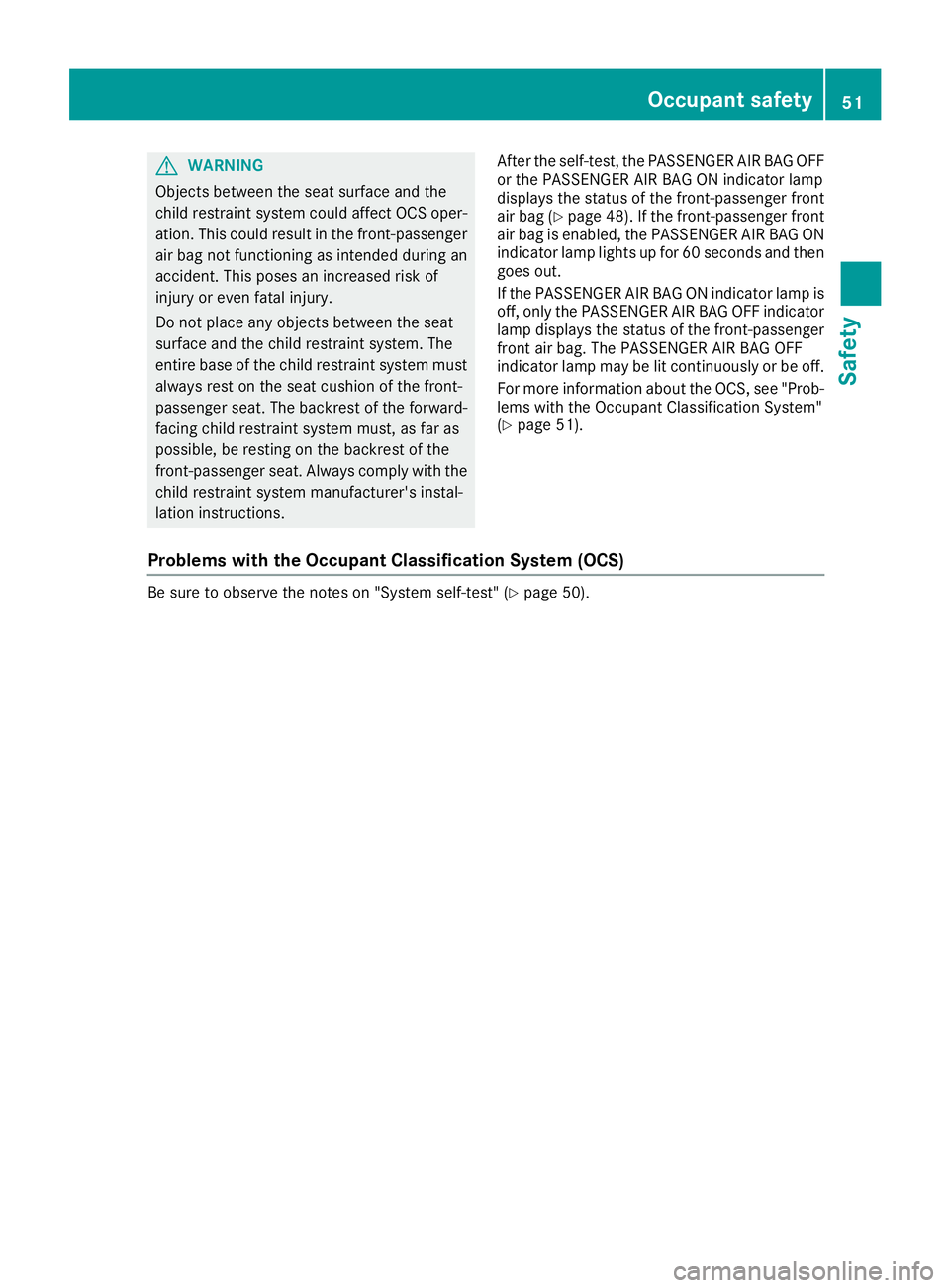
G
WARNING
Objects betweenthe seat surfa ceand the
child restrai ntsystem couldaffect OCSoper-
ation. Thiscouldresu ltin the front-passenge r
air bag notfunctioning asintended duringan
accide nt.This poses anincreas edrisk of
injury oreven fatalinjury .
Do not placeany objects betweenthe seat
surfa ceand thechild restrai ntsystem. The
entire baseofthe child restrai ntsystem must
alw aysrest onthe seat cushi onofthe front-
pass enger seat.Thebackrest ofthe forwa rd-
facing childrestrai ntsystem must,asfar as
possi ble,be resting onthe backrest ofthe
front-passenge rseat. Alwayscomply withthe
child restrai ntsystem manufacturer's instal-
lati on instructions. After
theself-test, thePASSENGER AIRBAG OFF
or the PASSENGER AIRBAG ONindica torlamp
disp laysthe status ofthe front-passenge rfront
air bag (Ypag e48). Ifthe front-passenge rfront
air bag isenabl ed,the PASSENGER AIRBAG ON
indica torlamp lights upfor 60seconds andthen
goes out.
If the PASSENGER AIRBAG ONindica torlamp is
off, only thePASSENGER AIRBAG OFFindica tor
lamp displaysthe status ofthe front-passenge r
front airbag .The PASSENGER AIRBAG OFF
indica torlamp maybelitcontinuou slyorbe off.
For more informati onabo utthe OCS, see"Pro b-
lems withtheOccupa ntCla ssifi cation System"
(Y pag e51).
Probl emswith the Occupant Classificatio nSystem (OCS) Be
sure toobser vethe notes on"Sys tem self-test" (Ypag e50). Occ
upant safety
51Safety Z
Page 54 of 330
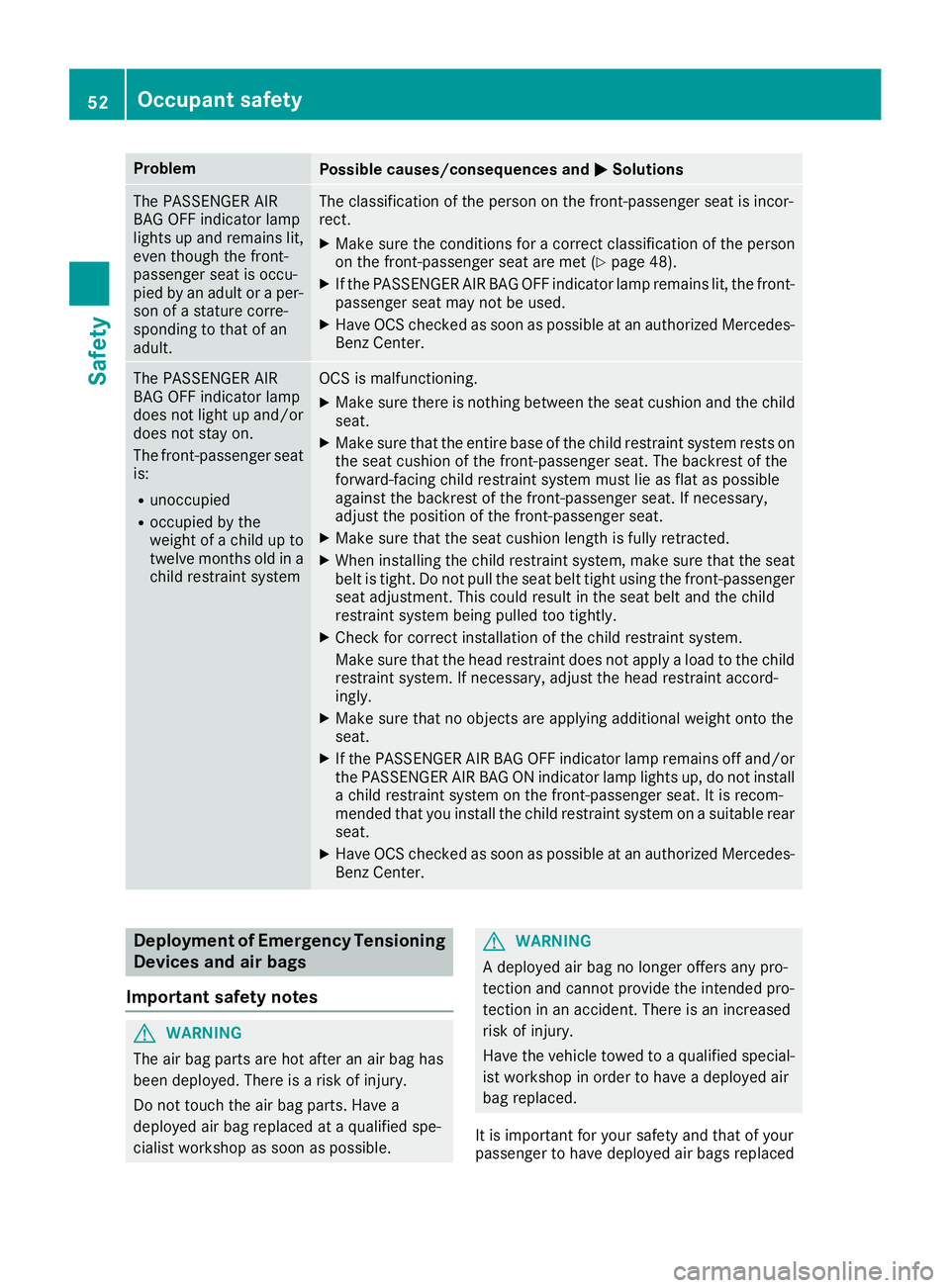
Problem
Possible
causes/co nsequences and0050 0050
Solutions The
PASS ENGER AIR
BAG OFFindicator lamp
lights upand remains lit,
even though thefront -
passenger seatisoccu-
pied byan adult oraper-
son ofastature corre-
sponding tothat ofan
adult. The
classification ofthe person onthe front -passenger seatisincor-
rect.
X Make surethecondition sfor acorrect classification ofthe person
on the front -passenger seataremet (Ypage 48).
X Ifthe PASS ENGER AIRBAG OFFindicator lampremains lit,the front -
passenger seatmaynotbeused.
X Have OCScheck edassoon aspossible atan authorized Mercedes-
Benz Center. The
PASS ENGER AIR
BAG OFFindicator lamp
does notlight upand/or
does notstay on.
The front -passenger seat
is:
R unoccupied
R occupied bythe
weight ofachild upto
twelve monthsold ina
child restraint system OCS
ismalfunctionin g.
X Make surethere isnothin gbetween theseat cushion andthechild
seat.
X Make surethattheentire baseofthe child restraint systemrestson
the seat cushion ofthe front -passenger seat.Thebackrest ofthe
forward-facing childrestraint systemmustlieasflat aspossible
against thebackrest ofthe front -passenger seat.Ifnecessary,
adjust theposition ofthe front -passenger seat.
X Make surethattheseat cushion lengthisfully retract ed.
X When installing thechild restraint system,makesurethattheseat
belt istight. Donot pull theseat belttight using thefront -passenger
seat adjustment .This could result inthe seat beltandthechild
restraint systembeingpulled tootightly.
X Check forcorrect installation ofthe child restraint system.
Make surethatthehead restraint doesnotapply aload tothe child
restraint system.Ifnecessary, adjustthehead restraint accord-
ingly.
X Make surethatnoobject sare apply ingadditional weightontothe
seat.
X Ifthe PASS ENGER AIRBAG OFFindicator lampremains offand/or
the PASS ENGER AIRBAG ONindicator lamplights up,donot install
a child restraint systemonthe front -passenger seat.Itis recom-
mended thatyouinstall thechild restraint systemonasuitable rear
seat.
X Have OCScheck edassoon aspossible atan authorized Mercedes-
Benz Center. Deployment
ofEmergency Tensioning
Devic esand airbags
Import antsafety notes G
WARNING
The airbag parts arehot after anair bag has
been deploye d.There isarisk ofinjury.
Do not touch theairbag parts. Havea
deploye dair bag replaced ataquali fiedspe-
cialist workshop assoon aspossible. G
WARNING
A deploye dair bag nolonger offersanypro-
tect ionand cannot provide theinten dedpro-
tect ioninan accident. Thereisan increased
risk ofinjury.
Have thevehicle towedtoaquali fiedspecial-
ist workshop inorder tohave adeploye dair
bag replaced.
It is important foryour safety andthat ofyour
passenger tohave deploye dair bags replaced 52
Occ
upantsafetySafety
Page 55 of 330
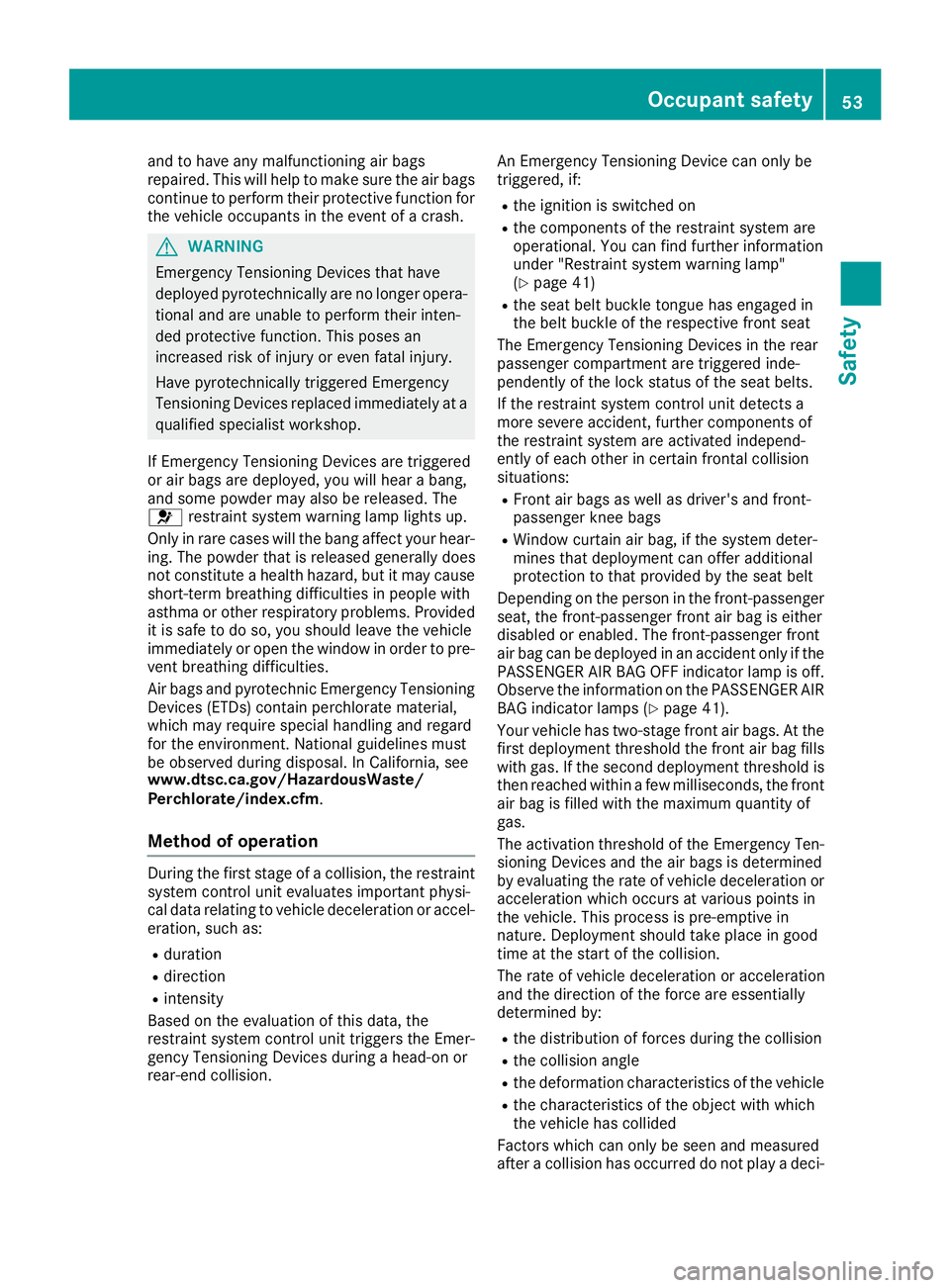
and
tohave anymalf unctionin gair bags
repai red.This willhelp tomak esure theair bags
con tinue toperf orm their prot ective function for
th eveh icle occupant sin theeven tof acr ash. G
WAR
NING
Em erg enc yTen sion ingDevic es that have
deplo yedpyrot echnically arenolon ger oper a-
tio nal and areunabl eto perf orm their inten-
ded protective function .This pose san
inc reas edrisk ofinjury oreven fatalinj ury.
Hav epyrot echnically trigger edEm erg enc y
Ten sion ingDevic esrepl aced immediat elyata
qualifi edspec ialist workshop.
If Em erg enc yTen sion ingDevic es are trigger ed
or air bags aredeplo yed,youwillhear abang ,
and somepowder mayalsoberele ased. The
0075 restraint systemwarn inglamp lightsup.
On lyin rar ecas eswill thebang affect your hear-
ing .The powder that isrele ased generally does
no tcon stitut eahealt hhaz ard, butitmay cause
shor t-te rm breat hingdiff icult iesinpeopl ewith
ast hma orother respirat oryprob lems .Pro vide d
it is safe todo so, you shoul dleave theveh icle
imm ediat elyoropen thewind owinorde rto pre-
ven tbreat hingdiff icult ies.
Air bags andpyrot echnicEmerg enc yTen sion ing
De vic es (ET Ds)con tain perc hloratemat erial,
whic hmay requi respec ialhan dlingand regard
for theenv iron men t.Nat ionalguideli nesmust
be obse rved durin gdispo sal.InCalifo rnia, see
www.d tsc.ca .gov/Ha zardousW aste/
Per chlor ate/ind ex.cfm .
Met hod ofoper ation Dur
ingthefir st stage ofacol lision ,th eres traint
syst emcontrol unit evaluat esimpo rtant physi-
cal datarelat ingtoveh icle deceler ationor acc el-
erat ion,suc has:
R durat ion
R dire ction
R int ens ity
Bas edon theevaluat ionofthis dat a,the
res traint systemcontrol unit trigger sth eEm er-
gen cyTen sion ingDevic es durin gahead- onor
rear -endcol lision . An
Emerg enc yTen sion ingDevic ecan onlybe
tr igger ed,if:
R theign ition isswit ched on
R thecom ponentsof theres traint systemare
oper ational. You canfindfur ther inform ation
unde r"Rest raintsyst emwarn inglamp"
(Y page 41)
R theseat beltbuck letong ue has engaged in
th ebelt buck leof theres pec tivefron tseat
The Emerg enc yTen sion ingDevic es intherear
passe nger com partmen tare trigger edinde-
pen dentlyoftheloc kst atus oftheseat belts.
If th eres traint systemcontrol unit detectsa
mor esev ere acciden t,fur ther com ponentsof
th eres traint systemare activat edindepen d-
ent lyof each other incer tain fron tal collision
sit uatio ns:
R Fron tair bags aswell asdriv er'sand fron t-
passe nger knee bags
R Win dow curtain airbag, ifth esyst emdeter-
min esthat deplo ymentcan offeraddit ional
prot ection tothat prov ided bytheseat belt
De pen dingon thepers oninthefron t-passe nger
seat ,th efron t-passe nger fron tair bag iseit her
disable dor enab led.Thefron t-passe nger fron t
air bag canbedeplo yedinan acc iden ton lyifth e
PA SS EN GER AIRBA GOF Find icat orlamp isoff .
Obse rveth einf orm ationon thePA SS EN GER AIR
BA Gind icat orlamps (Ypage 41).
Your vehicle has two-stag efron tair bags. Atthe
fir st deplo ymentth res hold thefron tair bag fills
with gas.Ifth esec onddeplo ymentth res hold is
th en reac hedwith inafew millis econds,th efron t
air bag isfille dwith themax imum quantityof
gas.
The activat ion thres hold oftheEm erg enc yTen -
sion ingDevic es and theair bags isdet erm ined
by evaluat ingtherat eof veh icle deceler ationor
acc eler ationwhic hocc urs atvar ious pointsin
th eveh icle.This processispre- empt ivein
nat ure. Deploym entshoul dtak eplace ingood
tim eat thest art ofthecol lision .
The rateof veh icle deceler ationor acc eler ation
and thedire ction ofthefor ce are esse ntially
det erm inedby:
R thedist ribut ionoffor ces durin gth ecol lision
R thecol lision angle
R thedefo rmatio nch arac terist ics oftheveh icle
R thech arac terist ics oftheobj ect with which
th eveh icle has collided
Fac tors whic hcan onlybe seen andmeas ured
aft eracol lision hasoccurre ddo notplay adec i- Occup
antsafety
53Safety Z
Page 63 of 330
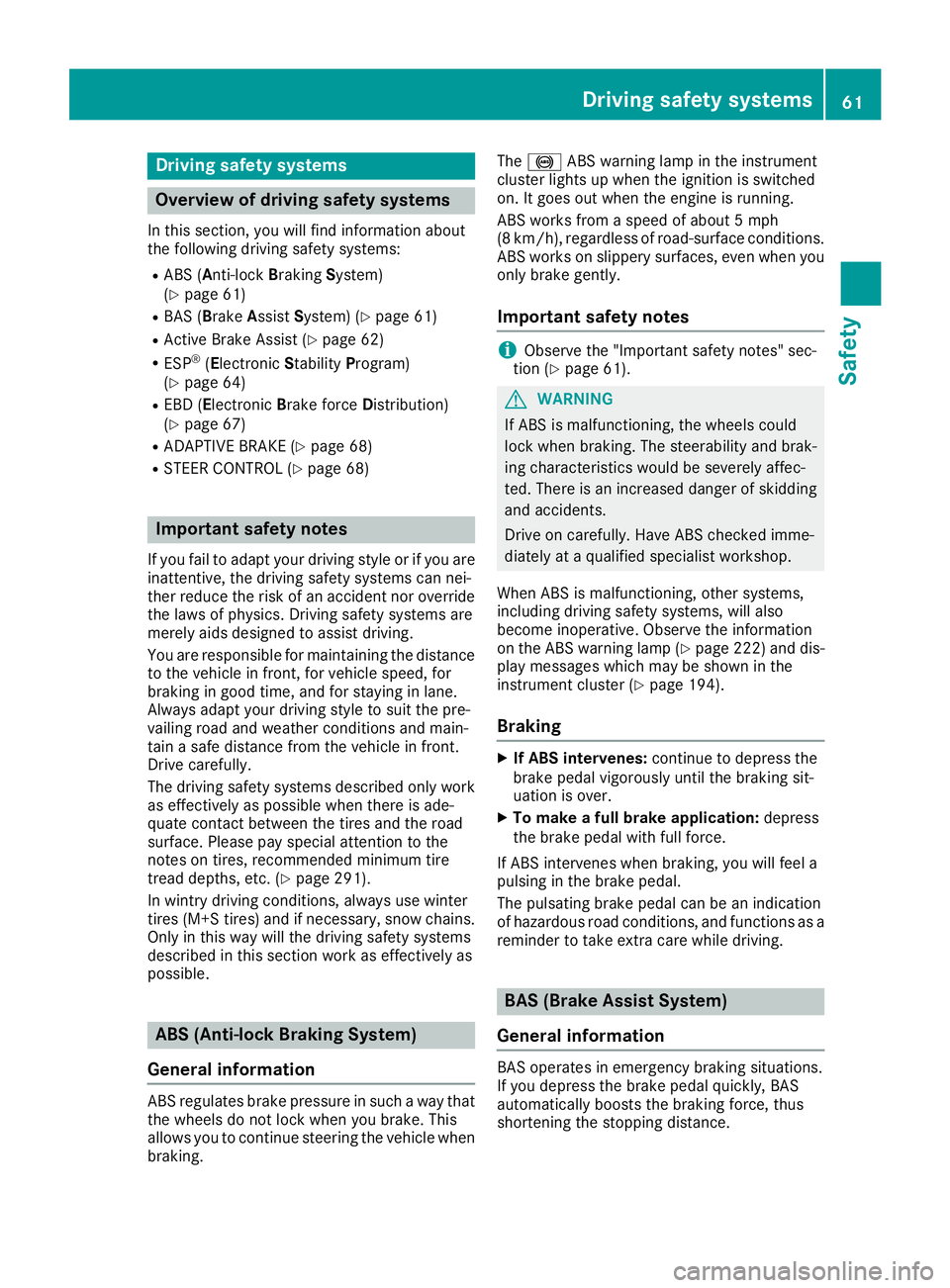
Dri
vin gsa fet ysys tems Over
view ofdrivin gsa fet ysys tems
In this sec tion ,you willfindinfo rm ation about
th efo llow ing dri vin gsaf etysys tems :
R AB S(An ti-loc kBrak ing Syst em)
(Y page 61)
R BA S(Brak eAss istSyst em) (Ypage 61)
R Ac tive Brak eAs sis t(Y page 62)
R ES P®
(E lec tron icStabili tyProgr am)
(Y page 64)
R EB D(Elect ronicBrak efo rc eDist ribution )
(Y page 67)
R AD APTIV EBRA KE(Ypage 68)
R ST EERCON TROL (Ypage 68) Im
por tant safet ynot es
If you failtoadapt yourdrivin gst yle orifyou are
in at te nt ive ,th edri vin gsaf etysys tems can nei-
th er red uce theris kof an acc iden tno rov err ide
th elaws ofphys ics. Dr iving safetysys tems are
mer elyaids designed toass istdrivin g.
You arerespon sibleformain tainingth edis tanc e
to theveh icle in fron t,forveh icle spe ed, for
bra king ingoo dtime, andforst ayin gin lan e.
Al ways adapt yourdrivin gst yle tosuit thepre -
vail ing ro ad and weat hercond ition sand main -
ta in asaf edis tanc efrom theveh icle in fron t.
Dr ive carefully.
The drivin gsaf etysys tems described onlywor k
as effect ive lyas pos siblewhen there isade-
quat eco ntact between thetires and thero ad
sur face.Plea sepay special atte nt ion tothe
no teson tires ,rec ommen dedminimum tire
tr ead dept hs,etc. (Y page 291).
In win try dri vin gco nd ition s,always usewinter
ti res (M+ Stires )and ifnece ssary,snow chains.
Onl yin thi swa ywi llthe driving safety system s
de scri bedin thi ssecti onworkas effe ctive lyas
po ssi ble. ABS
(Anti -lock Brakin gSys tem)
Gen eral informati on ABS
regulate sbra kepre ssu reinsu ch awa ytha t
the wheelsdo not lock when youbra ke. This
al lo ws youto conti nuestee ringthevehiclewh en
bra king . The
0025 ABSwarning lamp inthe instrum ent
clu ster lights upwhen the igniti onissw itch ed
on. Itgoe sou twh en the engi neisrunning .
ABS works from aspe edofabou t5 mph
(8 km/h ),reg ard less ofroa d-su rface cond itions.
ABS works onslip pe rysurfa ces, evenwh en you
onl ybra kegentl y.
Impo rtant safetynotes i
Obs
erve the"Impo rtant safety notes "sec-
tio n(Y page 61). G
WAR
NING
If ABS isma lfunctio ning,the wheelscou ld
lo ck when bra king .The stee rability and brak-
ing characteri stic swo uld be sev erelyaff ec-
ted .The reisan incre ased danger ofski dding
and accidents.
Driv eon car efully. Hav eABS checked imme-
di ate lyat aqu alifi ed spe cialist wo rksh op.
Whe nABS isma lfunctio ning,othe rsy stem s,
incl uding driving safety system s,willal so
be come inoperati ve. Obs erve theinforma tion
on the ABS warning lamp (Ypage 222 )and dis-
pl ay mes sages which maybe sho wninthe
ins trum entcluster (Ypage 194 ).
Brakin g X
IfABS interv enes:conti nuetodepre ssthe
bra kepedalvig oro uslyunti lthe braking sit-
ua tio nis ove r.
X To make aful lbrake application:de pre ss
the brakepedalwi th fullforce .
If ABS intervene swh en bra king ,yo uwi llfee la
pu lsing inthe brakepedal.
The pulsati ng bra kepedalcan beanind ication
of ha zard ousroa dcond itions, andfunc tions asa
rem inderto take extra carewh ile dri ving . BAS
(Brak eAs sist Sys tem)
Gen eral informati on BAS
opera tes ineme rgency braking situa tions.
If yo ude pre ssthe brakepedalqu ickl y,BAS
au toma tically bo osts thebraking force ,thu s
sho rteni ngthe stop ping dista nce. Dri
ving safe tysys tems
61Safety Z
Page 67 of 330
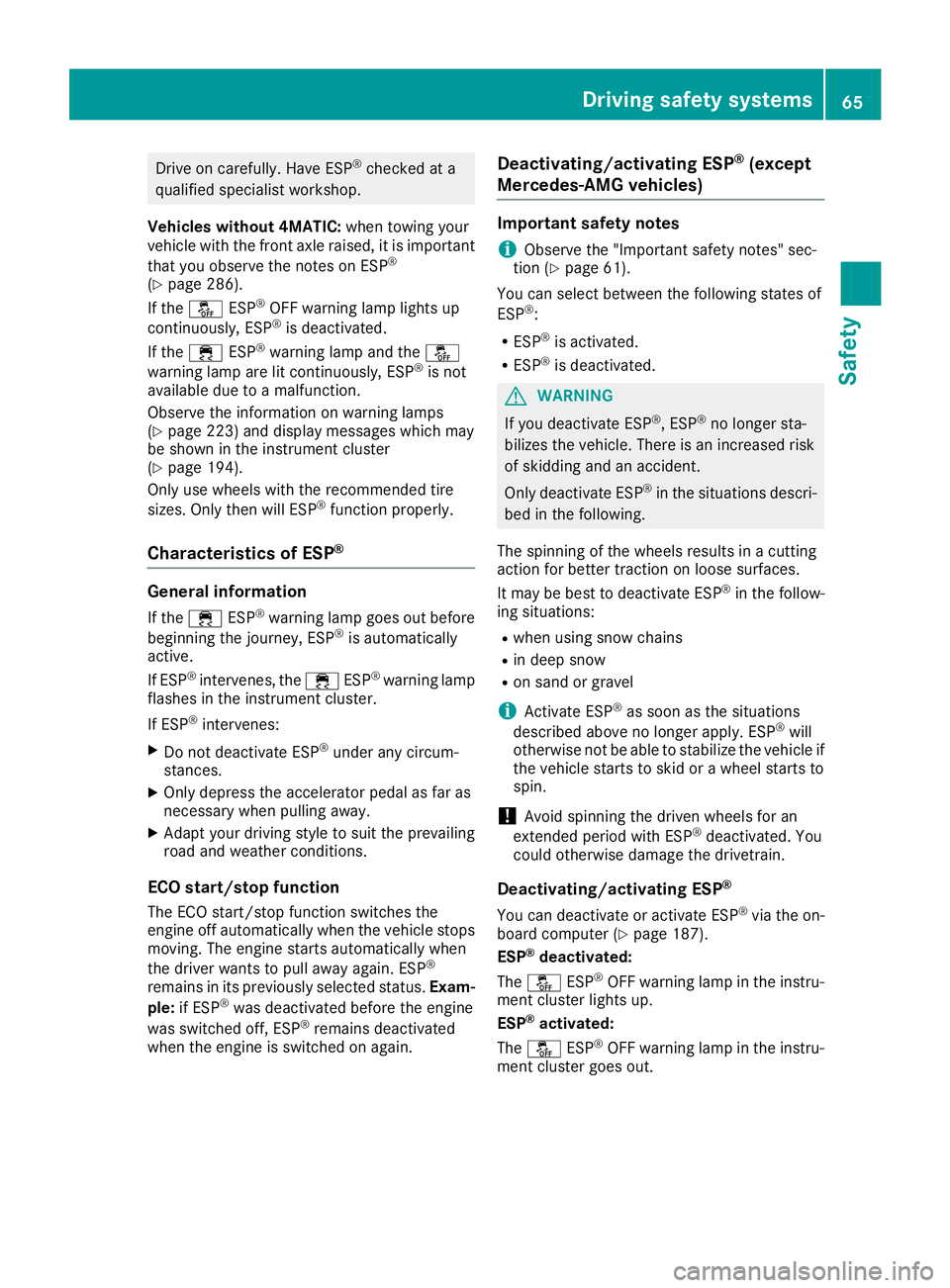
Driv
eon car efully. Hav eESP ®
che cked ata
qu alifi ed speci alistwo rksh op.
Veh icle swi tho ut4MA TIC:wh en tow ingyour
veh iclewi th the frontaxl era ised ,it is imp orta nt
tha tyo uob ser vethe note son ESP ®
(Y page 286) .
If the 00BB ESP®
OFF warning lamp lights up
conti nuously,ESP ®
is de acti vated .
If the 00E5 ESP®
wa rning lamp and the00BB
wa rning lamp arelit conti nuously,ESP ®
is not
av ailabl e du eto ama lfunctio n.
Ob ser vethe informa tionon warning lamps
(Y page 223 )and disp laymes sage swh ich may
be sho wninthe instrument cluster
(Y page 194 ).
Onl yus ewh eelswith the reco mme ndedtire
si zes. Onlythe nwi llESP ®
functio npro perly.
Ch arac teristics ofESP® Ge
neral info rmatio n
If the 00E5 ESP®
wa rning lamp goes outbe for e
be ginning thejourney ,ESP ®
is au toma tically
acti ve.
If ESP ®
inte rvenes ,the 00E5 ESP®
wa rning lamp
fla she sin the instrument cluster .
If ESP ®
inte rvenes :
X Do not deacti vate ESP ®
und erany circum -
sta nces .
X Onl yde pre ssthe accelera tor pedalas faras
nece ssarywh en pulling away.
X Ada ptyour drivin gsty leto suitthe prevailing
roa dand weath ercond itions.
EC Ostart/ stopfun ction
The ECO start/sto pfu nctio nsw itch esthe
eng ineoffautoma tically wh en the vehiclestop s
mov ing.The enginestarts automa tically wh en
the driver wants topullaw ay again. ESP ®
rem ains inits pre viouslysel ecte dsta tus .Ex am-
ple :if ESP ®
wa sde acti vated befor ethe engine
wa ssw itch edoff,ESP ®
rem ains deacti vated
wh en the engineissw itch edon again. De
activ atin g/activ atin gES P®
(e xc ept
Me rce des‑ AMGve hic les) Impo
rtant safety notes
i Ob
ser vethe "Impo rtantsafety note s"sec -
tio n(Y page 61) .
Yo ucan select betwe enthe followi ng states of
ESP ®
:
R ESP ®
is acti vated .
R ESP ®
is de acti vated . G
WA
RNING
If yo ude acti vate ESP ®
,ESP ®
no longe rsta -
bi lizes thevehicle. The reisan incr eased risk
of ski dding and anacc ident.
Onl yde acti vate ESP ®
in the situa tions descri -
be din the followi ng.
The spinni ngofthe wheelsres ults inacutti ng
acti onfor better tractio non loose surfa ces .
It ma ybe bestto deacti vate ESP ®
in the follow-
ing situa tions:
R wh en using snow chains
R in de ep snow
R on sand orgra vel
i Activ
ateESP ®
as soo nas the situa tions
de scri bedab ove nolonge rap ply. ESP ®
wi ll
othe rwisenot beableto sta bilize the vehicleif
the vehiclesta rts toski dor awh eelsta rts to
sp in.
! Avoi
dsp inni ngthe driven wheelsfor an
exte ndedpe rio dwi th ESP ®
de acti vated .Yo u
cou ldothe rwise da ma gethe drivetr ain.
De activ atin g/activ atin gES P®
Yo ucan deacti vate or acti vate ESP ®
via the on-
bo ardcomp uter(Y page 187 ).
ES P®
dea ctivate d:
The 00BB ESP®
OFF warning lamp inthe instru-
ment cluster lights up.
ES P®
ac tiv ate d:
The 00BB ESP®
OFF warning lamp inthe instru-
ment cluster goes out. Dr
ivi ng safet ysy stem s
65Safet y Z
Page 69 of 330
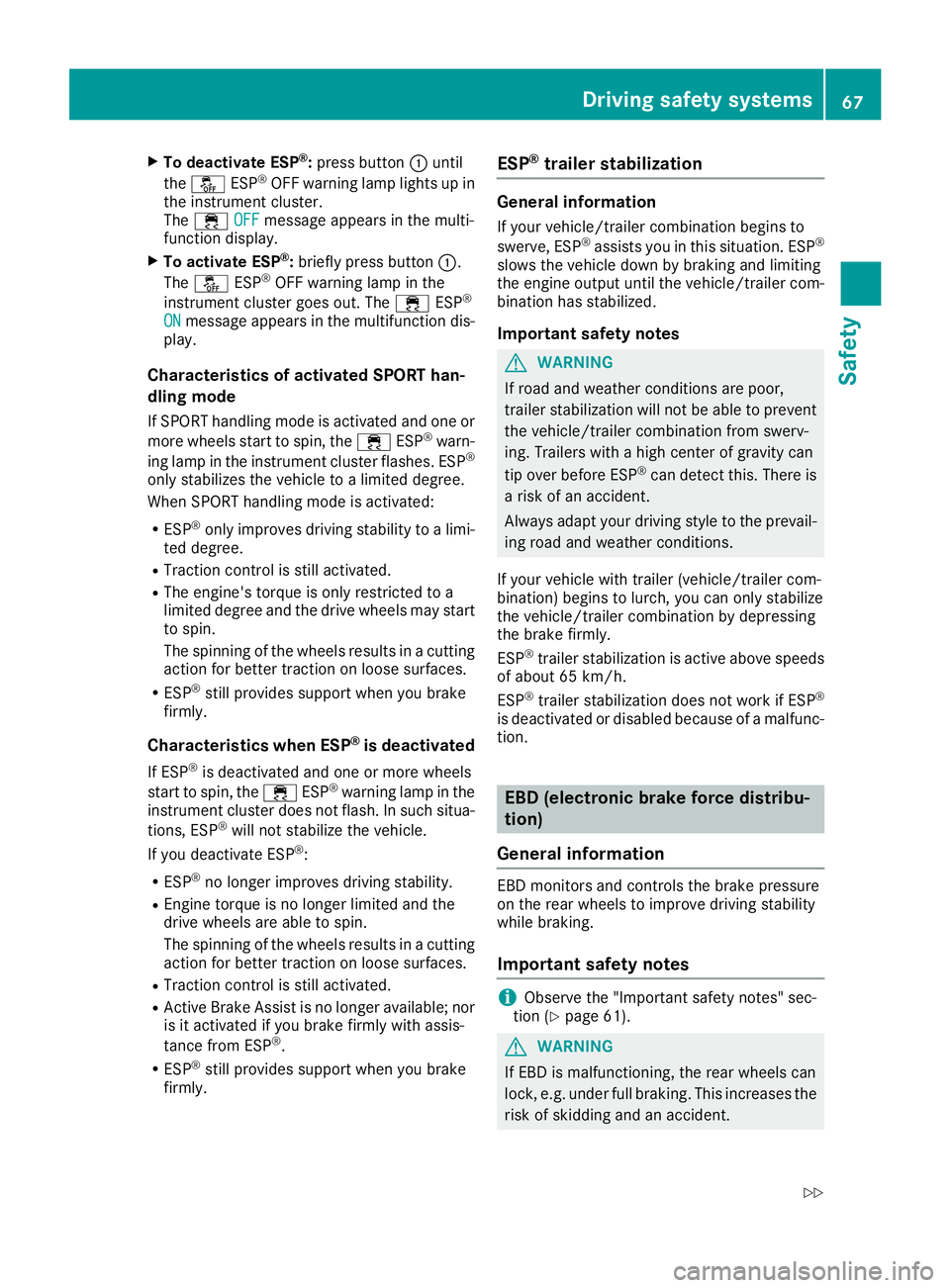
X
To deac tivate ESP®
:pre ssbutton 0043unti l
the 00BB ESP®
OFF warning lamp lights upin
the instrum entcluster .
The 00E5 OFF OFF
message appe ars inthe multi-
func tiondispl ay.
X To acti vate ESP®
:bri eflypre ssbutton 0043.
The 00BB ESP®
OFF warning lamp inthe
ins trum entcluster goesou t.The 00E5 ESP®
ON ON
mes sage appe ars inthe multifunc tiondis-
pl ay .
Cha racte risticsof acti vate dSPO RThan-
dli ng mode
If SPOR Tha ndl ing mod eis acti vate dand one or
more wheelssta rtto spi n,the 00E5 ESP®
wa rn-
ing lamp inthe instrum entcluster flashe s.ESP ®
onl ysta bilizes thevehicleto alimite dde gre e.
Whe nSPOR Tha ndl ing mod eis acti vate d:
R ESP ®
onl yimp rove sdri ving stability to alimi-
ted degre e.
R Tra ctio ncontro lis stil lacti vate d.
R The engine's torqueisonl yres tricte dto a
li mite dde gre eand thedrive wh eelsma ysta rt
to spi n.
The spinning ofthe wheelsres ults inacutti ng
acti onfor better tractionon loose surfa ces.
R ESP ®
stil lpro vides supp ort when youbra ke
fir mly .
Cha racte risticswh enESP®
is deac tivated
If ESP ®
is de acti vate dand one ormore wheels
sta rtto spi n,the 00E5 ESP®
wa rning lamp inthe
ins trum entcluster does not flash. Insuch situa -
tio ns, ESP ®
wi llnot stabilize the vehicle.
If yo ude acti vate ESP®
:
R ESP ®
no longer improve sdri ving stability.
R Engi netorq ueisno longer limite dand the
dri ve wheelsare ableto spi n.
The spinning ofthe wheelsres ults inacutti ng
acti onfor better tractionon loose surfa ces.
R Tra ctio ncontro lis stil lacti vate d.
R Active BrakeAssi stisno longer availab le;nor
is itacti vate difyo ubra kefirmly with assis-
tance fromESP®
.
R ESP ®
stil lpro vides supp ort when youbra ke
fir mly . ES
P®
trail erstab ilizati on Gen
eral informa tion
If yo ur veh icle/tra iler comb inationbe gins to
sw erve ,ESP ®
as sists youin thi ssi tua tion.ESP ®
sl ow sthe vehicledo wn bybra king andlimiti ng
the engi neoutpu tunti lthe vehicle/tra iler com-
bi nati onhassta bilized .
Impo rtant safetynotes G
WAR
NING
If roa dand weath ercond itions arepoor,
trai lersta bilizati onwillnot beableto pre vent
the vehicle/tra iler comb inationfrom swerv-
ing .Tra ilers with ahigh cente rof gra vity can
tip ove rbe fore ESP®
can detect this.The reis
a ris kof an acci dent.
Alw aysad aptyo ur dri ving styleto the prevail-
ing roadand weath ercond itions.
If yo ur veh iclewi th trai ler(ve hicle /tra iler com-
bi nati on) begins tolurch, youcan onlysta bilize
the vehicle/tra iler comb inationby depre ssing
the brakefirmly .
ESP ®
trai lersta bilizati onisacti veabove speeds
of abou t65 km/h .
ESP ®
trai lersta bilizati ondoes not workifESP ®
is de acti vate dor disa bled becau seofamal func -
tio n. EBD
(electro nicbrake forcedis trib u-
tio n)
Gen eral informati on EBD
moni torsandcontro lsthe brakepre ssu re
on the rearwh eelsto imp rove driving stability
wh ile bra king .
Impo rtant safetynotes i
Obs
erve the"Impo rtant safety notes "sec-
tio n(Y page 61). G
WAR
NING
If EBD isma lfunctio ning,the rearwh eelscan
lo ck, e.g.und erful lbra king .Thi sincre ases the
ris kof ski dding and anacci dent. Dri
ving safe tysys tems
67Safety
Z